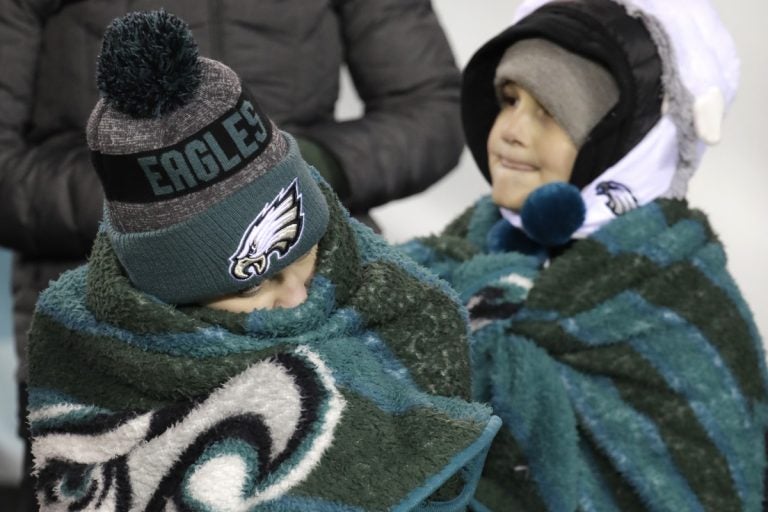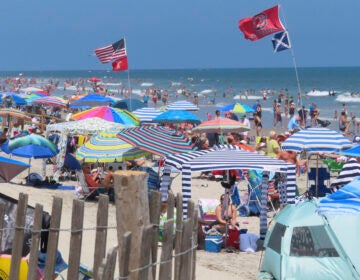Tips for Eagles fans: How to dress in layers for a Minnesota winter
Layering is the key to cold-weather dressing, and it works for "any part of the body whether the head, feet and hands or the main core of your body."

Young fans watch during the first half of an NFL divisional playoff football game between the Philadelphia Eagles and the Atlanta Falcons, Saturday, Jan. 13, 2018, in Philadelphia. (Chris Szagola/AP Photo)
Dressing right for winter is a useful thing to know, whether you’re a football fan attending a tailgate party in Super Bowl host city Minneapolis, or just looking to enjoy outdoor activities in any other cold-weather destination.
The Associated Press asked Steve Schreader of Midwest Mountaineering, an outdoor gear store in Minneapolis, for advice on winter wear. Done right, he says, your winter wear should create “a nice, warm, cozy feeling,” no matter how cold it gets.
Layering
Layering is the key to cold-weather dressing, and it works for “any part of the body whether the head, feet and hands or the main core of your body,” Schreader said.

For your upper torso, begin with a long-sleeved base layer — either soft merino wool or a synthetic polyester shirt — next to your skin. The fabric should breathe and be relatively light so you don’t sweat or overheat. Schreader said he would stay away from cotton or cotton blends here.
Next, put on a mid-layer, like a fleece pullover or hoodie. Schreader mentioned the Patagonia R1 as an example. The mid-layer is “going to be your first line of insulation,” Schreader said, providing a “heat transfer” and preventing body heat from evaporating, “allowing you to keep that body heat to your core.”
The top layer should be a shell that serves as a windbreaker. If the temperatures are likely to be extremely cold, you’ll want a “big puffy jacket.” That “big insulating layer” creates an air pocket that keeps your body heat in and serves as a “barrier between you and the rest of the elements,” he said.
He recommends that both the mid-layer and the outer shell have hoods.
For the bottom half of your body, you may want to layer long underwear beneath canvas pants. But beware of jeans or 100 percent cotton pants, which don’t protect well against the cold and don’t dry fast if they get wet.
Feet
Start with a light pair of woolen hiking socks. Then add a mid-layer of “thick, almost fluffy” wool socks designed for hiking, trekking or even mountaineering, Schreader said.
Boots like Merrell Moabs or the Sorel brand will then keep those feet dry and warm, he said.
“Your feet are probably the one thing that if they’re not comfortable, the rest of you is not going to be comfortable,” he said. But you also “don’t want to overdress your feet,” because if they sweat, “you’re going to get clammy,” and that will feel cold.
Head
“Most of the extremities that get frostbitten first are on my head — my nose, my ears, my cheeks,” Schreader said.
Use the hood from your mid-layer, and add a beanie or stocking cap. A neck gaiter that can be scrunched down or pulled up can add a layer across your face.
Another headgear option: “full fur, with the full flaps. You’ll look the kids from ‘A Christmas Story.'”
Hands
Start with a lightweight liner glove, like a Polartec. Look for the touchscreen finger pad design so you can use your phone screen.
Add mittens that have liners as well as outer shells. Schreader says he recommends mittens for the main hand coverage because “having your fingers closer together, not isolated, is going to create a better heat pocket in your hands.” And you can always add a packet of disposable air-activated hand warmers.
Online: Midwest Mountaineering, http://www.midwestmtn.com/
Follow Jeff Baenen on Twitter at https://twitter.com/jeffbaenen. Find more of his work at https://apnews.com/search/jeff%20baenen
WHYY is your source for fact-based, in-depth journalism and information. As a nonprofit organization, we rely on financial support from readers like you. Please give today.




